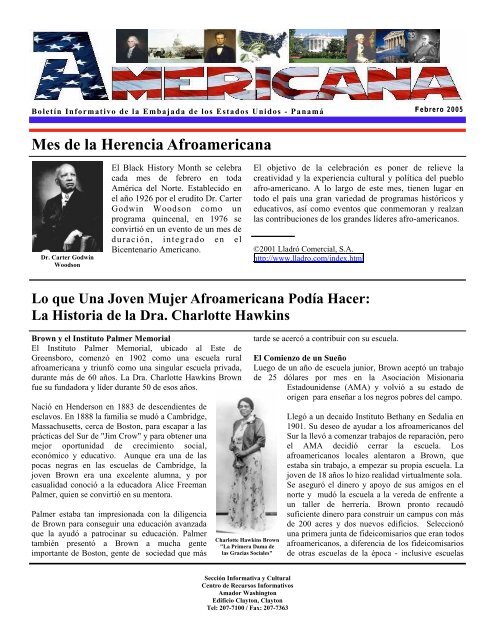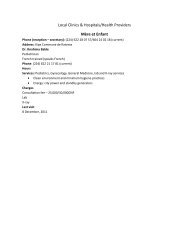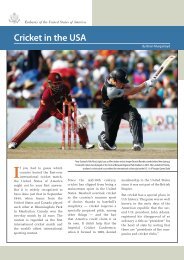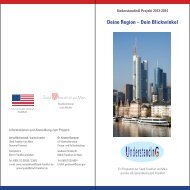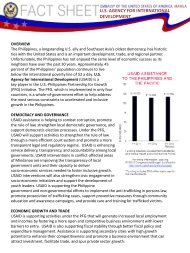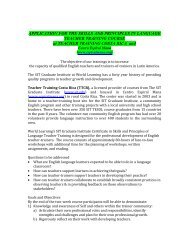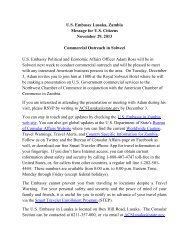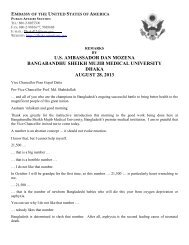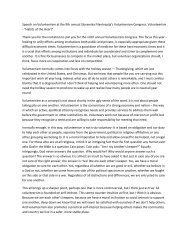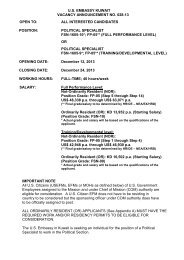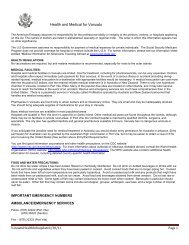Mes de la Herencia Afroamericana
Mes de la Herencia Afroamericana
Mes de la Herencia Afroamericana
You also want an ePaper? Increase the reach of your titles
YUMPU automatically turns print PDFs into web optimized ePapers that Google loves.
Boletín Informativo <strong>de</strong> <strong>la</strong> Embajada <strong>de</strong> los Estados Unidos - Panamá<br />
<strong>Mes</strong> <strong>de</strong> <strong>la</strong> <strong>Herencia</strong> <strong>Afroamericana</strong><br />
Dr. Carter Godwin<br />
Woodson<br />
El B<strong>la</strong>ck History Month se celebra<br />
cada mes <strong>de</strong> febrero en toda<br />
América <strong>de</strong>l Norte. Establecido en<br />
el año 1926 por el erudito Dr. Carter<br />
Godwin Woodson como un<br />
programa quincenal, en 1976 se<br />
convirtió en un evento <strong>de</strong> un mes <strong>de</strong><br />
duración, integrado en el<br />
Bicentenario Americano.<br />
Lo que Una Joven Mujer <strong>Afroamericana</strong> Podía Hacer:<br />
La Historia <strong>de</strong> <strong>la</strong> Dra. Charlotte Hawkins<br />
Brown y el Instituto Palmer Memorial<br />
El Instituto Palmer Memorial, ubicado al Este <strong>de</strong><br />
Greensboro, comenzó en 1902 como una escue<strong>la</strong> rural<br />
afroamericana y triunfó como una singu<strong>la</strong>r escue<strong>la</strong> privada,<br />
durante más <strong>de</strong> 60 años. La Dra. Charlotte Hawkins Brown<br />
fue su fundadora y lí<strong>de</strong>r durante 50 <strong>de</strong> esos años.<br />
Nació en Hen<strong>de</strong>rson en 1883 <strong>de</strong> <strong>de</strong>scendientes <strong>de</strong><br />
esc<strong>la</strong>vos. En 1888 <strong>la</strong> familia se mudó a Cambridge,<br />
Massachusetts, cerca <strong>de</strong> Boston, para escapar a <strong>la</strong>s<br />
prácticas <strong>de</strong>l Sur <strong>de</strong> "Jim Crow" y para obtener una<br />
mejor oportunidad <strong>de</strong> crecimiento social,<br />
económico y educativo. Aunque era una <strong>de</strong> <strong>la</strong>s<br />
pocas negras en <strong>la</strong>s escue<strong>la</strong>s <strong>de</strong> Cambridge, <strong>la</strong><br />
joven Brown era una excelente alumna, y por<br />
casualidad conoció a <strong>la</strong> educadora Alice Freeman<br />
Palmer, quien se convirtió en su mentora.<br />
Palmer estaba tan impresionada con <strong>la</strong> diligencia<br />
<strong>de</strong> Brown para conseguir una educación avanzada<br />
que <strong>la</strong> ayudó a patrocinar su educación. Palmer<br />
también presentó a Brown a mucha gente<br />
importante <strong>de</strong> Boston, gente <strong>de</strong> sociedad que más<br />
Charlotte Hawkins Brown<br />
"La Primera Dama <strong>de</strong><br />
<strong>la</strong>s Gracias Sociales"<br />
Sección Informativa y Cultural<br />
Centro <strong>de</strong> Recursos Informativos<br />
Amador Washington<br />
Edificio C<strong>la</strong>yton, C<strong>la</strong>yton<br />
Tel: 207-7100 / Fax: 207-7363<br />
tar<strong>de</strong> se acercó a contribuir con su escue<strong>la</strong>.<br />
Febrero 2005<br />
El objetivo <strong>de</strong> <strong>la</strong> celebración es poner <strong>de</strong> relieve <strong>la</strong><br />
creatividad y <strong>la</strong> experiencia cultural y política <strong>de</strong>l pueblo<br />
afro-americano. A lo <strong>la</strong>rgo <strong>de</strong> este mes, tienen lugar en<br />
todo el país una gran variedad <strong>de</strong> programas históricos y<br />
educativos, así como eventos que conmemoran y realzan<br />
<strong>la</strong>s contribuciones <strong>de</strong> los gran<strong>de</strong>s lí<strong>de</strong>res afro-americanos.<br />
©2001 L<strong>la</strong>dró Comercial, S.A.<br />
http://www.l<strong>la</strong>dro.com/in<strong>de</strong>x.html<br />
El Comienzo <strong>de</strong> un Sueño<br />
Luego <strong>de</strong> un año <strong>de</strong> escue<strong>la</strong> junior, Brown aceptó un trabajo<br />
<strong>de</strong> 25 dó<strong>la</strong>res por mes en <strong>la</strong> Asociación Misionaria<br />
Estadouni<strong>de</strong>nse (AMA) y volvió a su estado <strong>de</strong><br />
origen para enseñar a los negros pobres <strong>de</strong>l campo.<br />
Llegó a un <strong>de</strong>caido Instituto Bethany en Sedalia en<br />
1901. Su <strong>de</strong>seo <strong>de</strong> ayudar a los afroamericanos <strong>de</strong>l<br />
Sur <strong>la</strong> llevó a comenzar trabajos <strong>de</strong> reparación, pero<br />
el AMA <strong>de</strong>cidió cerrar <strong>la</strong> escue<strong>la</strong>. Los<br />
afroamericanos locales alentaron a Brown, que<br />
estaba sin trabajo, a empezar su propia escue<strong>la</strong>. La<br />
joven <strong>de</strong> 18 años lo hizo realidad virtualmente so<strong>la</strong>.<br />
Se aseguró el dinero y apoyo <strong>de</strong> sus amigos en el<br />
norte y mudó <strong>la</strong> escue<strong>la</strong> a <strong>la</strong> vereda <strong>de</strong> enfrente a<br />
un taller <strong>de</strong> herrería. Brown pronto recaudó<br />
suficiente dinero para construir un campus con más<br />
<strong>de</strong> 200 acres y dos nuevos edificios. Seleccionó<br />
una primera junta <strong>de</strong> fi<strong>de</strong>icomisarios que eran todos<br />
afroamericanos, a diferencia <strong>de</strong> los fi<strong>de</strong>icomisarios<br />
<strong>de</strong> otras escue<strong>la</strong>s <strong>de</strong> <strong>la</strong> época - inclusive escue<strong>la</strong>s
con orientación afroamericana. Luego <strong>de</strong> contratar un<br />
reducido personal y <strong>de</strong> asegurarse el apoyo adicional <strong>de</strong> los<br />
lí<strong>de</strong>res locales negros y b<strong>la</strong>ncos, el Instituto Palmer<br />
Memorial (Palmer) comenzó a operar.<br />
El Palmer ofrecía a los jóvenes afroamericanos rurales <strong>la</strong><br />
inusual oportunidad <strong>de</strong> un aprendizaje cultural. El objetivo <strong>de</strong><br />
<strong>la</strong> escue<strong>la</strong> era brindar un lugar don<strong>de</strong> los negros pudieran<br />
escapar <strong>de</strong> <strong>la</strong> entonces común conjetura <strong>de</strong> que los<br />
afroamericanos eran innatamente inferiores a los b<strong>la</strong>ncos y<br />
no necesitaban una educación más allá <strong>de</strong> una capacitación<br />
vocacional.<br />
En 1900 Carolina <strong>de</strong>l Norte tenía más <strong>de</strong> 2.000 escue<strong>la</strong>s<br />
operadas privadamente para afroamericanos. Sin embargo, <strong>la</strong><br />
mayoría <strong>de</strong> los maestros sólo tenían una educación <strong>de</strong> escue<strong>la</strong><br />
elemental y podían instruir a sus estudiantes sólo hasta ese<br />
nivel.<br />
El Palmer era diferente porque Brown ofrecía instrucción<br />
preparatoria para <strong>la</strong> universidad en un ambiente <strong>de</strong> los dos<br />
últimos años <strong>de</strong> escue<strong>la</strong> secundaria. Las<br />
c<strong>la</strong>ses incluían drama, música, arte,<br />
matemáticas, literatura y lenguas romances.<br />
Los alumnos estaban divididos en pequeños<br />
grupos en círculo con maestros que hacían <strong>de</strong><br />
asesores y consejeros. Cada estudiante recibía<br />
capacitación personal en apariencia y<br />
<strong>de</strong>sarrollo <strong>de</strong> carácter. Todos los estudiantes<br />
tenían que trabajar una hora por día para <strong>la</strong><br />
escue<strong>la</strong>.<br />
Problemas y Victorias<br />
Para 1915 el Palmer se había ganado el apoyo<br />
<strong>de</strong> figuras nacionales tales como el lí<strong>de</strong>r<br />
educativo Booker T. Washington, el<br />
presi<strong>de</strong>nte <strong>de</strong> <strong>la</strong> Universidad <strong>de</strong> Harvard<br />
Charles William Eliot, y los filántropos <strong>de</strong><br />
Boston Carrie y Galen Stone.<br />
Luego <strong>de</strong> que un gran incendio <strong>de</strong>struyera dos <strong>de</strong> los seis<br />
edificios principales en 1917, <strong>la</strong> <strong>de</strong>terminación <strong>de</strong> Brown<br />
para recaudar dinero para compensar por <strong>la</strong> pérdida evitó el<br />
cierre <strong>de</strong> <strong>la</strong> escue<strong>la</strong>. El exitoso esfuerzo también aumentó <strong>la</strong><br />
cooperación birracial, o tanto negra como b<strong>la</strong>nca para el<br />
Palmer y su comunidad.<br />
Los Stone, b<strong>la</strong>ncos <strong>de</strong>l norte, se convirtieron en los más<br />
gran<strong>de</strong>s donadores <strong>de</strong>l Palmer. Eran los primeros gran<strong>de</strong>s<br />
donadores para apoyar al Palmer por el enfoque holístico <strong>de</strong><br />
<strong>la</strong> educación total y sus programas <strong>de</strong> artes liberales <strong>de</strong><br />
calidad para educar a los estadouni<strong>de</strong>nses negros más allá <strong>de</strong><br />
los niveles <strong>de</strong> capacitación básicos.<br />
El renovado apoyo birracial y los esfuerzos <strong>de</strong> recaudación<br />
<strong>de</strong> fondos y un aumento en <strong>la</strong>s contribuciones <strong>de</strong> toda <strong>la</strong><br />
nación resultaron en <strong>la</strong> construcción <strong>de</strong>l primer importante<br />
edificio <strong>de</strong> <strong>la</strong>drillo y un nuevo estatus como única escue<strong>la</strong><br />
secundaria rural, para afroamericanos o b<strong>la</strong>ncos, en el<br />
Condado <strong>de</strong> Guilford. Cuando otro edificio c<strong>la</strong>ve se incendió<br />
en 1922, un Palmer financieramente más fuerte y más<br />
orientado hacia <strong>la</strong> comunidad continuó con sus operaciones<br />
normales.<br />
Brown introdujo más c<strong>la</strong>ses <strong>de</strong> artes liberales y matemática<br />
avanzada y cursos <strong>de</strong> ciencias a estudiantes <strong>de</strong>l Palmer.<br />
Introdujo el estudio <strong>de</strong> historia afroamericana en un momento<br />
en que ninguna otra escue<strong>la</strong> secundaria <strong>de</strong> Carolina <strong>de</strong>l Norte<br />
<strong>la</strong> enseñaba.<br />
Una Educación Holística para Elevar al Individuo<br />
Brown se tomó un año para viajar y estudiar. En Europa<br />
compartió i<strong>de</strong>as con <strong>la</strong>s educadoras negras Mary McLeod y<br />
Nannie Helen Burroughs. Juntas, estas tres mujeres eran<br />
conocidas como <strong>la</strong>s "Tres Bes <strong>de</strong> <strong>la</strong> Educación." Las Tres<br />
Bes creían en combinar un triángulo holístico <strong>de</strong> i<strong>de</strong>as y<br />
lecciones para lograr igualidad racial; el triángulo <strong>de</strong> Brown<br />
combinaba <strong>la</strong> educación, religión, y <strong>la</strong>s proezas; el triángulo<br />
<strong>de</strong> Bethune era "<strong>la</strong> cabeza, el corazón y <strong>la</strong><br />
mano"; el <strong>de</strong> Burroughs era "el libro, <strong>la</strong> Biblia<br />
y <strong>la</strong> escoba." Para mediados <strong>de</strong> los años 1920<br />
Brown era una oradora conocida a nivel<br />
nacional que ponía énfasis en <strong>la</strong> enseñanza <strong>de</strong><br />
estos conceptos a través <strong>de</strong> <strong>la</strong> cultura y <strong>la</strong>s<br />
artes liberales para <strong>la</strong> elevación racial.<br />
A nivel estatal, el<strong>la</strong> ayudó a crear <strong>la</strong> primera<br />
escue<strong>la</strong> para niñas afroamericanas<br />
<strong>de</strong>lincuentes. Con el correr <strong>de</strong>l tiempo,<br />
Brown comenzó una escue<strong>la</strong> junior y<br />
contruyó un nuevo dormitorio para varones.<br />
La creciente reputación <strong>de</strong>l Palmer atrajo<br />
cada vez más estudiantes <strong>de</strong> c<strong>la</strong>se media y<br />
alta <strong>de</strong> <strong>la</strong>s conocidas familias <strong>de</strong> los Estados<br />
Unidos, África, Bermuda, América Central y<br />
Cuba.<br />
En 1937 Brown cerró los <strong>de</strong>partamentos <strong>de</strong> escue<strong>la</strong> elemental<br />
y junior y convenció a los funcionarios <strong>de</strong>l Condado <strong>de</strong><br />
Guilford <strong>de</strong> abrir <strong>la</strong> primera escue<strong>la</strong> secundaria pública rural<br />
para afroamericanos <strong>de</strong>l condado. Se hizo conocida como <strong>la</strong><br />
"primera dama <strong>de</strong> <strong>la</strong>s gracias sociales" luego <strong>de</strong> aparecer en<br />
<strong>la</strong> radio nacional y publicar el libro Hacer, Decir y Usar lo<br />
Correcto en 1940. A mediados <strong>de</strong> los años 1940 Brown<br />
recaudó 100.000 dó<strong>la</strong>res para una fundación, y <strong>la</strong> revista<br />
Ebony <strong>de</strong>dicó su artículo principal al prestigioso Palmer en<br />
don<strong>de</strong> lo <strong>de</strong>scribió como "<strong>la</strong> única... escue<strong>la</strong> <strong>de</strong> su tipo en<br />
Estados Unidos."<br />
En 1952 Brown se retiró luego <strong>de</strong> 50 años. Eligió a<br />
Wilhelmina M. Crosson <strong>de</strong> Boston para suce<strong>de</strong>r<strong>la</strong> para ser <strong>la</strong><br />
próxima presi<strong>de</strong>nta <strong>de</strong>l Palmer. Luego <strong>de</strong> una <strong>la</strong>rga<br />
enfermedad Brown murió en 1961 y fue enterrada con gran<br />
honor en el campus que amaba.
El Instituto Palmer Memorial se ha convertido en un sitio<br />
histórico. Fue el primer sitio mantenido por el estado para<br />
honrar <strong>la</strong>s contribuciones <strong>de</strong> los afroamericanos y <strong>la</strong>s<br />
mujeres. Los continuos programas <strong>de</strong>scriben <strong>la</strong> historia y el<br />
<strong>de</strong>sarrollo <strong>de</strong> <strong>la</strong> educación afroamericana en Carolina <strong>de</strong>l<br />
Norte.<br />
El legado <strong>de</strong> <strong>la</strong> escue<strong>la</strong> también sigue viviendo a través <strong>de</strong><br />
generaciones <strong>de</strong> estudiantes y graduados que han recibido <strong>la</strong><br />
influencia <strong>de</strong> <strong>la</strong> filosofía <strong>de</strong>l Palmer: "Educar al individuo<br />
para que viva en un mundo mejor." Se han hecho conocidos<br />
en el mundo como escritores y cantantes,<br />
maestros y profesores, doctores y<br />
abogados, actores y actrices, científicos y<br />
matemáticos, y funcionarios <strong>de</strong> gobierno.<br />
Wilhelmina Crosson<br />
Wilhelmina M. Crosson (1900-1991) fue <strong>la</strong><br />
segunda presi<strong>de</strong>nta <strong>de</strong>l Instituto Palmer<br />
Memorial. Nacida en Warrenton, se mudó<br />
con sus padres a Boston, Massachusetts, en<br />
1906, don<strong>de</strong> fue una excelente estudiante y<br />
<strong>la</strong> mejor jugadora <strong>de</strong>l equipo <strong>de</strong> básquetbol<br />
<strong>de</strong> <strong>la</strong> escue<strong>la</strong>.<br />
Des<strong>de</strong> una temprana edad, Crosson soñaba con ser maestra.<br />
Comenzó a enseñar en 1920 y empezó el primer programa <strong>de</strong><br />
lectura terapéutica <strong>de</strong> Boston. También se distinguió por ser<br />
una <strong>de</strong> <strong>la</strong>s primeras mujeres afroamericanas en enseñar inglés<br />
e historia. Crosson aprendió sobre el triángulo <strong>de</strong> <strong>la</strong><br />
educación <strong>de</strong> Charlotte Hawkins Brown. El triángulo <strong>de</strong><br />
Recursos en Internet<br />
B<strong>la</strong>ck History Month<br />
B<strong>la</strong>ck History Month<br />
http://usinfo.state.gov/usa/b<strong>la</strong>ckhis/<br />
Gateway to African-American History<br />
B<strong>la</strong>ck History Month & Kit Themes: 2002-2010<br />
http://www.asalh.com/main_pages/bhm.htm<br />
Annual B<strong>la</strong>ck History Month Theme Events and Materials.<br />
Education First: B<strong>la</strong>ck History Hotlist, a collection of<br />
internet sites<br />
http://www.kn.pacbell.com/wired/BHM/bh_hotlist.html<br />
The following resources come from all over the Internet. Some<br />
are provi<strong>de</strong>d by companies like CNN Interactive while others<br />
are the products of university scho<strong>la</strong>rs or amateurs. Use these<br />
sites as the raw material for your own study of<br />
African-American history and issues.<br />
Wilhelmina M. Crosson<br />
Crosson se centró en lograr <strong>la</strong> eficiencia educativa, <strong>la</strong><br />
seguridad cultural y <strong>la</strong> sinceridad religiosa para todos los<br />
estudiantes.<br />
Deseosa <strong>de</strong> ayudar a los niños <strong>de</strong> su propia raza, aceptó <strong>la</strong><br />
responsabilidad <strong>de</strong> enseñar a los estudiantes afroamericanos<br />
<strong>de</strong> quienes el sistema <strong>de</strong> escue<strong>la</strong>s ya se estaba por rendir.<br />
Para <strong>la</strong> sorpresa <strong>de</strong> muchos, Crosson reformó a aquellos<br />
niños olvidados. Logró prestigio nacional en 1952 cuando se<br />
convirtió en <strong>la</strong> segunda presi<strong>de</strong>nta <strong>de</strong>l Instituto Palmer<br />
Memorial. Mantuvo el prestigio <strong>de</strong> <strong>la</strong> escue<strong>la</strong> durante 14<br />
años.<br />
Martin Luther King Jr. Day (Jan. 17) and<br />
African-American History Month: February 2005<br />
http://www.census.gov/Press-Release/www/releases/archives/<br />
facts_for_features_special_editions/003065.html<br />
The birthday of Martin Luther King Jr. has been observed as a<br />
fe<strong>de</strong>ral holiday on the third Monday in January since 1986. To<br />
recall and celebrate the positive contributions to our nation ma<strong>de</strong><br />
by people of African <strong>de</strong>scent, American historian Carter G.<br />
Woodson established B<strong>la</strong>ck History Week beginning on Feb. 12,<br />
1926.<br />
B<strong>la</strong>ck History Month Resources<br />
http://www.ed.gov/free/bhm.html<br />
Featured Resources.<br />
De: "What One Young African American<br />
Woman Could Do: The Story of Dr.<br />
Charlotte Hawkins Brown and the Palmer<br />
Memorial Institute." Tar Heel Junior<br />
Historian (Fall 1995), por Charles W.<br />
Wa<strong>de</strong>lington<br />
El Sr. Wa<strong>de</strong>lington investiga, documenta y<br />
preserva los roles afroamericanos en <strong>la</strong><br />
historia <strong>de</strong>l estado <strong>de</strong> Tar Heel para <strong>la</strong><br />
Sección <strong>de</strong> Sitios Históricos <strong>de</strong>l Estado <strong>de</strong> Carolina <strong>de</strong>l<br />
Norte. Se graduó <strong>de</strong> <strong>la</strong> Universidad Estatal <strong>de</strong><br />
Winston-Salem y <strong>la</strong> Universidad <strong>de</strong> Miami en Ohio y en este<br />
momento está trabajando en un manuscrito acerca <strong>de</strong><br />
Charlotte Hawkins Brown.<br />
Fuente:<br />
http://www.ah.dcr.state.nc.us/Spanish/sections/hs/chb/chb-pmi.htm<br />
The African American Experience<br />
http://lii.org/bhmonth<br />
Resources re<strong>la</strong>ted to B<strong>la</strong>ck History Month, and Beyond.
B<strong>la</strong>ck History Month<br />
http://www2.worldbook.com/wc/popup?path=features/<br />
aajourney_new&page=html/aa_5_title.shtml&direct=yes<br />
B<strong>la</strong>ck History Month is an annual observance, in February, of<br />
the past achievements and current status of African Americans.<br />
El mes <strong>de</strong> <strong>la</strong> Historia <strong>Afroamericana</strong><br />
http://www.thebeehive.org/spanish/family/b<strong>la</strong>ck-history.asp<br />
En <strong>la</strong> década <strong>de</strong>l 1920, el Dr. Carter Godwin Woodson, un<br />
erudito afro-americano, <strong>de</strong>cidió que ya no podía más. Él estaba<br />
cansado <strong>de</strong> que <strong>la</strong> historia fuera siempre sobre los b<strong>la</strong>ncos, que<br />
<strong>la</strong>s contribuciones <strong>de</strong> los afro americanos fueran ignoradas.<br />
Entonces, en el 1926, creó <strong>la</strong> "Semana <strong>de</strong> <strong>la</strong> Historia Negra,"<br />
que se utilizó para educar a <strong>la</strong>s personas sobre <strong>la</strong> historia Negra<br />
mediante reuniones, exhibiciones y discursos.<br />
El significado real <strong>de</strong> <strong>la</strong> Historia <strong>de</strong>l <strong>Mes</strong> Afroamericano por<br />
Nelson Peery<br />
http://www.lrna.org/league/PT/PT.1999.02/PT.1999.02.8.html<br />
La historia afroamericana es el corazón <strong>de</strong> <strong>la</strong> historia <strong>de</strong> nuestro<br />
país.<br />
African American<br />
African American World<br />
http://www.pbs.org/wnet/aaworld/<br />
Your gui<strong>de</strong> to African American history and culture.<br />
The African-American Mosaic<br />
http://www.loc.gov/exhibits/african/intro.html<br />
A Library of Congress Resource Gui<strong>de</strong> for the Study of B<strong>la</strong>ck<br />
History & Culture<br />
National Parks Associated with African Americans: An<br />
Ethnographic Perspective<br />
http://www.cr.nps.gov/aad/PEOPLES/overview.htm<br />
National Parks Associated with African Americans: An<br />
Ethnographic Perspective provi<strong>de</strong>s an interactive map linked to<br />
many of the national park sites and resources that emphasize the<br />
integral role that African Americans p<strong>la</strong>yed in the <strong>de</strong>velopment<br />
of American culture, heritage, and history.<br />
African-American Celebration<br />
http://www.universitypark.org/africancelebration/in<strong>de</strong>x4.html<br />
List of links.<br />
African Americans – Culture, History, Legacy and Heritage<br />
of A Proud People<br />
http://www.africanamericans.com/<br />
This website is Dedicated To All Things For And About The<br />
African American Diaspora<br />
The National Association for the Advancement of Colored<br />
People<br />
http://www.naacp.org/<br />
For more than ninety five years, the NAACP built and grew on<br />
the collective courage of thousands of people. People of all<br />
races, nationalities and faiths united on one premise --that all<br />
men and women are created equal.<br />
Association for the Study of African American Life and History<br />
(ASALH)<br />
http://www.asalh.com/intro.htm<br />
The Association for the Study of African American Life and<br />
History (ASALH), foun<strong>de</strong>d on September 9, 1915, by Dr. Carter<br />
Godwin Woodson and five others, in Chicago, Illinois, and<br />
incorporated October 3, 1915, un<strong>de</strong>r the <strong>la</strong>ws of the District of<br />
Columbia, is a non-profit, tax-exempt professional organization.<br />
Niagara Movement and W.E.B. Dubois<br />
Niagara Movement<br />
http://www.<strong>de</strong>p.state.pa.us/<strong>de</strong>p/monthlyprograms/<br />
b<strong>la</strong>ckhistory/2004/menu/niagara_movement.html<br />
The Niagara Movement was formed at Niagara Falls in 1905<br />
when W.E.B. DuBois, John Hope, Monroe Trotter, and 27<br />
others met secretly in the home of Mary B. Talbert, to adopt the<br />
resolutions which would lead to the founding of this movement.<br />
The Niagara Movement<br />
http://www.math.buffalo.edu/~sww/0history/hwny-niagaramovement.html<br />
In 1905, W.E.B. Dubois, John Hope, Monroe Trotter and 27<br />
others met secretly in the home of Mary B. Talbert, a prominant<br />
member of Buffalo's Michigan Street Baptist Church.<br />
Niagara Movement<br />
http://www2.worldbook.com/wc/popup?path=features/<br />
aajourney_new&page=html/aa_0_niagra.shtml&direct=yes<br />
Niagara movement was an organization foun<strong>de</strong>d by African<br />
Americans to fight racial discrimination in the United States. It<br />
existed from 1905 to 1910. At its height, the Niagara Movement<br />
had 30 branches in various U.S. cities.
The Niagara Movement by William Evitts (Buffalo and Erie<br />
County Historical Society)<br />
http://lucky.phpwebhosting.com/~ah/h/niag.html<br />
It can be argued that the 20th Century Civil Rights Movement<br />
began in Western New York and adjoining Fort Erie, Canada, in<br />
1905. An African-American organization created here espoused<br />
for the first time a mo<strong>de</strong>rn program of uncompromising protest<br />
and <strong>de</strong>mand for change, and led the way for the formation of the<br />
National Association for the Advancement of Colored People<br />
(NAACP) five years <strong>la</strong>ter.<br />
Niagara Movement at Harpers Ferry<br />
http://www.nps.gov/hafe/niagara/<br />
In 2006, Harpers Ferry National Historical Park will<br />
commemorate the 100th Anniversary of the gathering of the<br />
Niagara Movement, the first major civil rights organization of<br />
the 20th century.<br />
DuBois Biography<br />
http://www.ukans.edu/kansas/crossingboundaries/page6c1.html<br />
W.E.B. Du Bois's biographer, Manning Marable, writes that<br />
"Few intellectuals have done more to shape the twentieth<br />
century than W.E.B. Du Bois." His life covered a tremendous<br />
range of activities and movements. Du Bois was both an<br />
intellectual and a social activist.<br />
William Edward Burghardt DuBois<br />
http://www.africawithin.com/dubois/dubois.htm<br />
Short biography and profiles.<br />
Bibliografía<br />
1. Smallwood, Arwin D. The at<strong>la</strong>s of African-American<br />
history and politics: from the s<strong>la</strong>ve tra<strong>de</strong> to mo<strong>de</strong>rn times.<br />
New York : McGraw-Hill, 1998.<br />
This reference book consists of more than 150 originally<br />
produced maps which trace the African experience throughout<br />
the world and in America, graphically reinforcing the facts.<br />
2. The African – American yellow pages. Puck Productions<br />
Inc. New York : Henry Holt and Company, 1996.<br />
This directory offers a broad range of African American life<br />
from the arts to the everyday—museums, career advice, colleges<br />
and universities, health care, vacation sites, also Internet sites.<br />
Inclu<strong>de</strong>s organizations, business, historic sites, services,<br />
publications, etc.<br />
A Biographical Sketch of W.E.B. DuBois by Gerald C.<br />
Hynes<br />
http://www.duboislc.org/html/DuBoisBio.html<br />
William Edward Burghardt DuBois, to his admirers, was by<br />
spirited <strong>de</strong>votion and scho<strong>la</strong>rly <strong>de</strong>dication, an attacker of<br />
injustice and a <strong>de</strong>fen<strong>de</strong>r of freedom.<br />
W.E.B. Du Bois<br />
http://aalbc.com/authors/dubois.htm<br />
Among the greatest scho<strong>la</strong>rs in American history stands Dr.<br />
W.E.B. Du Bois. A towering figure, a brilliant scho<strong>la</strong>r and a<br />
prolific writer<br />
W.E.B. Du Bois Institute for African and African American<br />
Research Harvard University<br />
http://www.fas.harvard.edu/~du_bois/<br />
The i<strong>de</strong>a for the W. E. B. Du Bois Institute for African and<br />
African American Research was proposed in the Report of the<br />
Faculty Committee on African and Afro-American Studies dated<br />
20 January 1969.<br />
Du Bois, W(illiam) E(dward) B(urghardt)<br />
http://search.eb.com/b<strong>la</strong>ckhistory/micro/179/2.html<br />
American sociologist, the most important b<strong>la</strong>ck protest lea<strong>de</strong>r in<br />
the United States during the first half of the 20th century. He<br />
shared in the creation of the National Association for the<br />
Advancement of Colored People (NAACP) in 1909 and edited<br />
The Crisis, its magazine, from 1910 to 1934. Late in life he<br />
became i<strong>de</strong>ntified with Communist causes.<br />
3. The state of B<strong>la</strong>ck America. National Urban League, Inc.<br />
New York: National Urban League, Inc., 1995.<br />
This edition focuses its consi<strong>de</strong>ration of the “B<strong>la</strong>ck Family”, on<br />
the near past, the present and the future. This edition meets the<br />
legacy posed by it pre<strong>de</strong>cessors of the <strong>la</strong>st quarter century: to<br />
spur a <strong>de</strong>eper, more comprehensive examination of the status of<br />
African Americans in the American nation.<br />
4. Lemman, Nicho<strong>la</strong>s. La tierra prometida: cómo <strong>la</strong> gran<br />
migración cambió a Estados Unidos. Título original: The<br />
promised <strong>la</strong>nd : the great b<strong>la</strong>ck migration and how it changed<br />
America. Traducción: Cristina Piña. Argentina: Grupo Editor<br />
Latinoamericano, 1994.<br />
Este libro presenta <strong>la</strong> historia <strong>de</strong> <strong>la</strong> migración afroamericana<br />
<strong>de</strong>s<strong>de</strong> <strong>la</strong>s zonas rurales <strong>de</strong>l sur hasta <strong>la</strong>s zonas urbanas <strong>de</strong>l norte<br />
<strong>de</strong> los Estados Unidos.
5. Moon marked and touched by sun: p<strong>la</strong>ys by African<br />
American women. Theatre Communications Group. New<br />
York : Theatre Communications Group, 1994.<br />
These p<strong>la</strong>ys address the struggle African-Americans face<br />
carrying the stories beyond a simple turn of thought, making<br />
them memorable.<br />
6. Jacob Lawrence: the migration series. The Phillips<br />
Collection. Washington, D.C. : The Rappahannock Press, 1993.<br />
Sixty panels of mesmerizing, poignant, memorable and powerful<br />
examples of the ability to transmute history into art.<br />
7. Harrison, Paul Carter. B<strong>la</strong>ck light: the African American<br />
hero. New York : Thun<strong>de</strong>r’s Mouth Press, 1993.<br />
Divi<strong>de</strong>d into 13 broad categories, ranging from social activists<br />
to rappers, this book offers a comprehensive scope of eighty-six<br />
African Americans whose outstanding achievements have had a<br />
significant effect on the b<strong>la</strong>ck experience.<br />
8. Wells, Diana. We have a dream: African-American visions<br />
of freedom. New York: Carroll & Graf Publishers, 1993.<br />
In this volume the African American dream is explored,<br />
articu<strong>la</strong>ted, embraced, en<strong>la</strong>rged, <strong>de</strong>fined, reviewed and re<strong>de</strong>fined<br />
in selections from the works of twenty-eight African American<br />
writers whose lifetimes span two centuries.<br />
9. Songs of my people. African Americans: a self portrait.<br />
Boston : Little, Brown & Company, 1992.<br />
An historic photo documentary of the world of<br />
African-Americans through the eyes of some leading<br />
photojournalists.<br />
10. Branch, Taylor. Martin Luther King y su tiempo: Estados<br />
Unidos <strong>de</strong>s<strong>de</strong> 1954 a 1963. Titulo original: Parting the waters.<br />
America in King years 1954 – 63. Traducción: Laura Nicastro.<br />
Argentina: Grupo Editor Latinoamericano, 1992.<br />
Este libro no es una biografía <strong>de</strong> Martin Luther King Jr., aunque<br />
él sea el centro <strong>de</strong> <strong>la</strong> historia. El autor trata <strong>de</strong> que biografía e<br />
historia se refuercen mutuamente al integrar una cantidad <strong>de</strong><br />
anécdotas personales a lo <strong>la</strong>rgo <strong>de</strong> todo el re<strong>la</strong>to <strong>de</strong> una época<br />
norteamericana.<br />
11. Blumberg, Rhoda Lois. Los <strong>de</strong>rechos civiles: <strong>la</strong> lucha por<br />
<strong>la</strong> libertad en <strong>la</strong> década <strong>de</strong> 1960. Título original: Civil rights:<br />
The 1960s freedom struggle. Traducción: Teresa Cillo.<br />
Argentina : Ediciones Tres Tiempos, 1988.<br />
Esta obra se refiere a <strong>la</strong> lucha por <strong>la</strong> libertad que irrumpió a<br />
mediados <strong>de</strong>l siglo XX y que fue conocida ampliamente por<br />
entonces como movimiento por los <strong>de</strong>rechos civiles.<br />
12. Fairclough, Adam. To re<strong>de</strong>em the soul of America: the<br />
Southern Christian Lea<strong>de</strong>rship Conference and Martin<br />
Luther King, Jr. Athens, Georgia: University of Georgia, 1987.<br />
The history of the Southern Christian Lea<strong>de</strong>rship Conference<br />
(SCLC) and its role in bringing about a second reconstruction in<br />
the South—one that ma<strong>de</strong> good the promise of the first.<br />
13. Jackson, Jesse L. Straight from the heart. Phi<strong>la</strong><strong>de</strong>lphia:<br />
Fortress Press, 1987.<br />
In his first book, Rev. Jackson speaks on a wi<strong>de</strong> variety of topics<br />
through thirty-six public speeches, sermons, eulogies, essays<br />
and interviews.<br />
14. Escritoras negras en el ámbito <strong>de</strong>l trabajo. Título original:<br />
B<strong>la</strong>ck women writers at work. Traducción: María <strong>de</strong> Lour<strong>de</strong>s<br />
Savignon Suárez. México: Noema Editores S.A., 1986.<br />
Catorce escritoras, a su manera, y <strong>de</strong> viva voz, nos llevan hasta<br />
el corazón <strong>de</strong> sus procesos creativos.<br />
15. Pyatt, Sherman E. Martin Luther King, Jr.: an annotated<br />
bibliography. New York: Greenwood Press, 1986.<br />
The book updates and en<strong>la</strong>rges William H. Fisher's 1977<br />
bibliography of King. Of particu<strong>la</strong>r importance in Pyatt's work is<br />
the inclusion of <strong>de</strong>c<strong>la</strong>ssified FBI documents on King from 1962<br />
until his <strong>de</strong>ath. The volume has 1,277 items (books, articles,<br />
government documents, dissertations, and theses).<br />
16. Schulke, Flip. King remembered. New York: W.W. Norton<br />
and Company, 1986.<br />
This volume chronicles his life, from birth in segregated At<strong>la</strong>nta,<br />
to education in Boston, to assassination in 1968 in Memphis,<br />
where he was supporting striking garbage collectors. It also<br />
documents the events that significantly changed Southern<br />
society: Montgomery's bus boycott, Birmingham's Project "C,<br />
and " Selma's bloody race riots.<br />
17. Ansbro, John J. Martin Luther King Jr.: el <strong>de</strong>sarrollo <strong>de</strong><br />
una mente. Título original: Martin Luther King Jr.: the making<br />
of a mind. Traducción: Manuel Ortiz Staines. México:<br />
Publigraphic S.A., 1985.<br />
Esta obra examina <strong>la</strong>s críticas <strong>de</strong> King sobre los programas <strong>de</strong>l<br />
cambio social <strong>de</strong> Booker T. Washington, W.E.B. Dubois,<br />
Marcus Garvey, Stokely Carmichael, Elijah Muhammad y<br />
Malcom X.<br />
18. Witherspoon, William Roger. Martin Luther King, Jr. …<br />
to the mountaintop. New York: Doubleday & Company, Inc.,<br />
1985.<br />
This study of King inclu<strong>de</strong>s more than 200 photographs<br />
carefully p<strong>la</strong>ced to support the narrative. Witherspoon compiles<br />
from personal interviews with key Civil Rights lea<strong>de</strong>rs and King<br />
confidantes conducted primarily in <strong>la</strong>te 1984, as well as from<br />
major secondary sources.
19. Who’s who among b<strong>la</strong>ck Americans 1985. 4 th Ed. Illinois:<br />
Educational Communications Inc., 1985.<br />
This fourth edition features approximately 15,000 entries.<br />
Contains updated and content expan<strong>de</strong>d biographies of<br />
outstanding individual in such fields as fine arts, sports, science,<br />
<strong>la</strong>w, government and others.<br />
20. Lawson, Steven F. In pursuit of power: Southern B<strong>la</strong>cks<br />
and electoral politics 1965 – 1982. New York : Columbia<br />
University Press, 1985.<br />
It examines the efforts of civil rights forces to redress<br />
grievances through fe<strong>de</strong>ral action, since passage of the 1965<br />
Voting Rights Act.<br />
21. Van Deburg, William L. S<strong>la</strong>very & race in American<br />
popu<strong>la</strong>r culture. Wisconsin: University of Wisconsin Press,<br />
1984.<br />
The author offers an interdisciplinary survey of American<br />
popu<strong>la</strong>r culture and its historical attitu<strong>de</strong>s toward s<strong>la</strong>very and<br />
race. This work covers more than three centuries, from the<br />
colonial era to the present.<br />
22. White, Joseph L. The psychology of b<strong>la</strong>cks: an<br />
Afro-American perspective. New Jersey: Prentice-Hall Inc.,<br />
1984.<br />
This book is about the psychological perspective, which is<br />
reflected in the behavior, attitu<strong>de</strong>s, lifestyles, and cultural<br />
heritage of B<strong>la</strong>ck Americans.<br />
23. Williamson, Joel. The crucible of race: B<strong>la</strong>ck – White<br />
re<strong>la</strong>tions in the American South since emancipation. New<br />
York: Oxford University Press, 1984.<br />
Drawing on an array of sources and perspectives—political,<br />
economic, psychological, literary—Williamson gives us<br />
extensive pictures of the Southern experience and of the<br />
interaction between b<strong>la</strong>cks and whites.<br />
24. Woodward, Comer Vann. American counterpoint: s<strong>la</strong>very<br />
and racism in the North/South dialogue. New York : Oxford<br />
University Press, 1983.<br />
Woodward focuses on race problems from colonial times to<br />
present, as he investigates the nature and origin of the myths and<br />
stereotypes that have arisen on these issues.<br />
25. Thompson, Robert Farris. F<strong>la</strong>sh of spirit: African and<br />
Afro-American art and philosophy. New York : Random<br />
House, 1983.<br />
This book shows with precision how five c<strong>la</strong>ssical African<br />
civilizations have shaped b<strong>la</strong>ck cultures throughout the<br />
Americas.<br />
26. Hyatt, Marshall. The Afro-American cinematic<br />
experience: an annotated bibliography & filmography.<br />
De<strong>la</strong>ware: Scho<strong>la</strong>rly Resources Inc., 1983.<br />
This bibliography, combined with the filmography, provi<strong>de</strong>s a<br />
blueprint for professionals interested in using the medium as a<br />
method for researching and/or teaching the b<strong>la</strong>ck experience.<br />
27. Berry, Mary Frances. Long memory: the b<strong>la</strong>ck experience<br />
in America. New York : Oxford University Press, 1982.<br />
This book tells the story of a people removed from their African<br />
home<strong>la</strong>nd and scattered along the vast shores of the Americas.<br />
28. Ansbro, John J. Martin Luther King Jr.: the making of a<br />
mind. New York : Orbis Books, 1982.<br />
This book examines King’s contribution as a philosopher and<br />
theologian to issues of racial and social justice and his drive to<br />
eradicate oppression through the doctrine of nonviolence.<br />
29. Oates, Stephen B. Let the trumpet sound: the life of<br />
Martin Luther King Jr. New York: Harper & Row, Publishers,<br />
1982.<br />
This book provi<strong>de</strong>s an examination of the life of Martin Luther<br />
King, Jr. as it portrays a very real man and his dream that shaped<br />
America's history.<br />
30. Drylongso: a self-portrait of b<strong>la</strong>ck America. New York :<br />
Random House, 1980.<br />
Forty-one narratives by drylongso (ordinary people) b<strong>la</strong>ck<br />
Americans, men and women who are working members of<br />
stable families that are achieving more than mere survival by<br />
living according to ancestral values.<br />
31. B<strong>la</strong>ck American reference book. New Jersey:<br />
Prentice-Hall Inc., 1976.<br />
This book is a single volume resource on b<strong>la</strong>ck Americans, with<br />
the inclusion of graphs, charts and statistics and anecdotes, it<br />
tells the complete story b<strong>la</strong>ck Americans in the 300 years of<br />
their presence on this continent.<br />
32. Driskell, David C. Two centuries of b<strong>la</strong>ck American art.<br />
Los Angeles County Museum of Art. New York: Alfred A.<br />
Publisher, 1976.<br />
A chronological collection of reproductions of 63 leading<br />
African-American artists, including paintings, sculptures,<br />
graphics and crafts ranging from dolls to walking sticks.<br />
33. Peplow, Michael. The new Negro renaissance: a legacy of<br />
writings from a revolutionary era. New York: Holt, Rinehart<br />
and Winston, 1975.<br />
This anthology is a chronicle of Negro activity during the<br />
Renaissance Era. Inclu<strong>de</strong>d is a broad range of one-act p<strong>la</strong>ys,<br />
poems, short stories, essays and excerpts from novels, by men<br />
and women who helped shape the mo<strong>de</strong>rn ethos.
34. Hatch, James V. B<strong>la</strong>ck Theater USA: 45 p<strong>la</strong>ys by b<strong>la</strong>cks<br />
Americans, 1847 –1974. The Free Press. New York :<br />
Macmil<strong>la</strong>n Publishing Co., Inc., 1974.<br />
This book is both an anthology of African-American drama and<br />
“a testimony to the brilliant accomplishments of b<strong>la</strong>ck<br />
Americans.” The forty-five p<strong>la</strong>ys inclu<strong>de</strong>d range from 1847 to<br />
the present, and shows the <strong>de</strong>velopment of a vital dramatic<br />
tradition in America.<br />
35. Adoff, Arnold. The poetry of b<strong>la</strong>ck America: an<br />
anthology of the 20 th century. New York: Harper & Row,<br />
Publishers, 1973.<br />
An anthology of the 20 th century African-American poetry in the<br />
United States.<br />
36. Wagner, Jean. B<strong>la</strong>ck poets of the United States: from Paul<br />
Laurence Dunbar to Langston Hughes. Chicago : University<br />
of Illinois Press, 1973.<br />
Wagner discusses the evolution of African-American lyrical<br />
expression to the end of the nineteenth century, focusing on<br />
Dunbar and his contemporaries. Emphasis is on the struggle of<br />
stereotypes stemming from minstrelsy, popu<strong>la</strong>r song and white<br />
writing.<br />
37. Cavalca<strong>de</strong>: Negro American writing from 1760 to the<br />
present. Edited by Arthur P. Davis. New York: Houghton<br />
Mifflin Company, 1971.<br />
This anthology provi<strong>de</strong>s a representative selection of as much as<br />
possible of the best prose and poetry written by Negro<br />
Americans since 1760. It is <strong>de</strong>signed for use as a text in Negro<br />
American literatures courses or as a supplementary text in<br />
American literature course.<br />
Estas obras pue<strong>de</strong>n ser consultadas en el<br />
Centro <strong>de</strong> Recursos Informativos Amador Washington<br />
ubicado en el Edificio C<strong>la</strong>yton, C<strong>la</strong>yton<br />
(antiguo Edificio 520)<br />
Teléfono: 227-7100 / Fax: 207-7363<br />
Centro <strong>de</strong> Recursos Informativos<br />
Amador Washington<br />
38. Flynn, James J. Negroes of achievement in mo<strong>de</strong>rn<br />
America. New York: Dodd, Mead and Company, 1970.<br />
Biographies of contemporary b<strong>la</strong>ck men and women who have<br />
earned honor for themselves and for their race in such wi<strong>de</strong><br />
fields as the ministry, education, music, invention, sports and<br />
others, most often after overcoming tremendous hardships and<br />
handicaps.<br />
39. Bergman, Peter M. The chronological history of the Negro<br />
in America. New York: Harper & Row, Publishers, 1969.<br />
Traces the history of African Americans from the arrival of the<br />
first s<strong>la</strong>ves to the civil rights movement of the 1960's and<br />
beyond and discusses their influence on America's.<br />
40. Fishel Jr., Leslie H. The Negro American: a documentary<br />
History. William Morrow and Company. Illinois: Scott,<br />
Foresman and Company, 1967.<br />
By using contemporary personal accounts, newspaper articles,<br />
travel tales, memoirs, speeches, and other documents, the<br />
author, traces the history of the American Negro from the<br />
African background through Colonial America and the<br />
Revolution, s<strong>la</strong>very and abolition, reconstruction, urbanization<br />
and renaissance, the New Deal to the March on Washington.<br />
41. Hughes, Langston. B<strong>la</strong>ck magic: a pictorial history of the<br />
Negro in American entertainment. New Jersey: Prentice Hall<br />
Inc., 1967.<br />
This book is a tribute to the <strong>la</strong>sting contribution by<br />
African-Americans to the world of entertainment. Beginning in<br />
the 1500s b<strong>la</strong>ck tradition, and culture make their way to current<br />
entertainment limelight.


